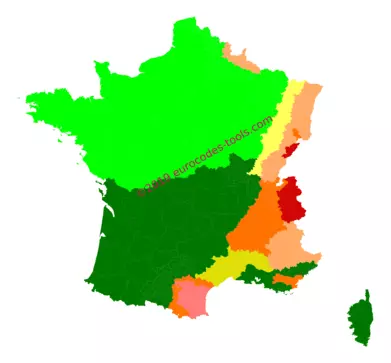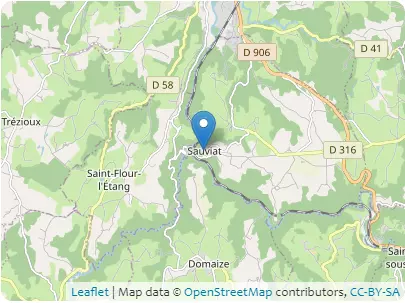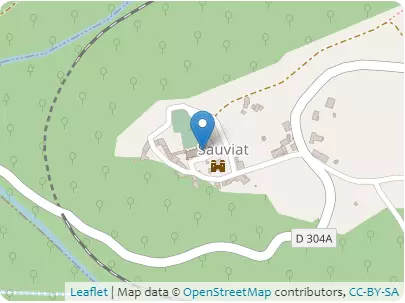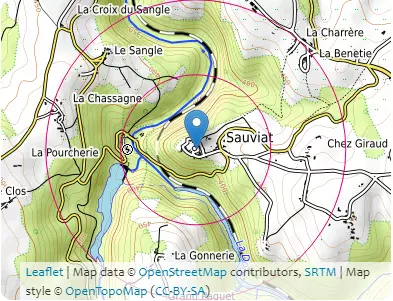
What are the French snow zones according to Eurocode 1 (NF EN 1991-1-3/NA) ?
On the map of the national annex, the French territory is divided into five regions of snow identified from A to E. Three of these regions (A to C) are subdivided into two parts to take into account accidental snow precipitation. The A2 amendment, published in July 2022, replaces the division by county with a division by town.
| Zone | A1 | A2 | B1 | B2 | C1 | C2 | D | E |
|---|---|---|---|---|---|---|---|---|
| Characteristic value of snow on the ground without elevation sk,0 | 0.45 kN/m2 | 0.45 kN/m2 | 0.55 kN/m2 | 0.55 kN/m2 | 0.65 kN/m2 | 0.65 kN/m2 | 0.90 kN/m2 | 1.40 kN/m2 |
| Design value of exceptional snow load on the ground> sk,0 | – | 1.00 kN/m2 | 1.00 kN/m2 | 1.35 kN/m2 | – | 1.35 kN/m2 | 1.80 kN/m2 | – |

The French overseas departments, overseas territories and overseas collectivities are not subject to snowfall except Saint Pierre and Miquelon.
Characteristic value of snow on the ground without elevation at Saint Pierre and Miquelon: sk,0 = 2.60kN/m2
How to determine the influence of elevation on the ground snow load in France ?
Two distinct variation laws must be applied depending on whether the construction is in snow zone E or not.
Snow loads are calculated as follows:
Up to 200m:
\[\displaystyle s_{k} = s_{k,0}\]From 200m to 500m:
All zones except zone E:
\[\displaystyle s_{k} = s_{k,0} + \frac{A}{1000} – 0.2\]Zone E only:
\[\displaystyle s_{k} = s_{k,0} + 1.5 \cdot \frac{A}{1000} – 0.3\]From 500m to 1000m:
All zones except zone E:
\[\displaystyle s_{k} = s_{k,0} + 1.5 \cdot \frac{A}{1000} – 0.45\]Zone E only:
\[\displaystyle s_{k} = s_{k,0} + 3.5 \cdot \frac{A}{1000} – 1.3\]From 1000m to 2000m:
All zones except zone E:
\[\displaystyle s_{k} = s_{k,0} + 3.5 \cdot \frac{A}{1000} – 2.45\]Zone E only:
\[\displaystyle s_{k} = s_{k,0} + 7 \cdot \frac{A}{1000} – 4.8\]where A is the elevation of the site.
How to adjust the ground snow load according to return period in France ?
\[\displaystyle s_{n} = s_{k} \cdot \left[ \frac{ 1 – V \cdot \frac{\sqrt 6}{\pi} \cdot [\ln(-\ln(1-P_{n})) + 0.57722] } {(1 + 2.5923 \cdot V)} \right]\]- Pn is the annual probability of exceedence :
- dwl is the design working life, in years.
- V is the coefficient of variation of annual maximum snow load with V=0.2 for a recurrence interval less than 50 years and V=0.6 for a recurrence interval greater than 50 years.
- It should not be applied for annual probabilities of exceedence greater than 0,2 (i.e. return period less than approximately 5 years).
Example of results given by the software Eurocodes Zoning
B1 – Localization
- Coordinates in World Geodetic System 1984 (WGS84) 3.5332°, 45.7153°
- Coordinates in French Geodetic System 1993 (Lambert 93) 741482m, 6512993m


Address D 304A, 63120 Sauviat, Auvergne-Rhône-Alpes
B2 – Altitudes

| Distances / Direction | At the place of construction | 500m | 1000m |
|---|---|---|---|
| North | 436 m | 360m | 407m |
| Northeast | 405m | 465m | |
| East | 456m | 473m | |
| Southeast | 419m | 446m | |
| South | 449m | 476m | |
| Southwest | 432m | 411m | |
| West | 360m | 468m | |
| Northwest | 403m | 452m |
B3 – Building
- Type of building: monumental building
- Design working life category: 100 years
- Max height: 15.0 m
- Orientation from North: 80°
B4 – Terrain categories

| Sectors | 1 | 2 | 3 | 4 |
|---|---|---|---|---|
| Categories | IIIa | IV | IV | IV |
C1 – Snow
NF EN 1991-1-3/NA (may 2007) + A1 (july 2011)
- Zone : A2(sk,0 = 0.45 kN/m²)
- Criteria for zoning : PUY-DE-DOME (63)
- Characteristic value of snow on the ground at the relevant site : sk,436 = 0.686 kN/m²
- Ground snow load with a return period of 100 years : s100 ans = 0.774 kN/m²
- Design value of exceptional snow load on the ground : sad = 1.0 kN/m²
C2 – Vent
NF EN 1991-1-4/NA (march 2008) + A1 (july 2011) + A2 (september 2012) + A3 (april 2019)
- Zone : 2(vb,0 = 24.0 m/s)
- Criteria for zoning : PUY-DE-DOME (63)
- Zone cdir : 1
| Sectors | 1 | 2 | 3 | 4 |
|---|---|---|---|---|
| Sector definition | from 35 ° to 125 ° | from 125 ° to 215 ° | from 215 ° to 305 ° | from 305 ° to 35 ° |
| Fundamental value of the basic wind velocity vb,0 | 24.0m/s | |||
| Shape parameter K | 0.2 | |||
| Exponent n | 0.5 | |||
| Annual probability of exceedence p | 0.01 | |||
| Probability factor cprob | 1.038 | |||
| Directional factor cdir | 0.7 | 1.0 | 1.0 | 1.0 |
| Basic wind velocity vb | 17.4m/s | 24.9m/s | 24.9m/s | 24.9m/s |
| Reference roughness length z0,II | 0.05m | |||
| Roughness length z0 | 0.2m | 1.0m | 1.0m | 1.0m |
| Terrain factor kr | 0.209 | 0.234 | 0.234 | 0.234 |
| Height above ground z | 15.0m | |||
| Minimum height zmin | 5.0m | 15.0m | 15.0m | 15.0m |
| Roughness factor cr(z) | 0.904 | 0.635 | 0.635 | 0.635 |
| Orography factor * co(z) | 1.0 | 1.0 | 1.0 | 1.0 |
| Mean wind velocity vm(z) | 15.8m/s | 15.8m/s | 15.8m/s | 15.8m/s |
| Turbulence factor kl | 0.97 | 0.854 | 0.854 | 0.854 |
| Standard deviation of the turbulence σv | 3.544m/s | 4.989m/s | 4.989m/s | 4.989m/s |
| Turbulence intensity Iv(z) | 0.225 | 0.315 | 0.315 | 0.315 |
| Air density ρ | 1.225kg/m3 | |||
| Exposure factor ce(z) | 2.102 | 1.292 | 1.292 | 1.292 |
| Peak velocity pressure qp(z) | 392.0N/m2 | 491.5N/m2 | 491.5N/m2 | 491.5N/m2 |
| Peak wind velocity for Serviceability Limit States vp(z),SLS | 91.1km/h | 102.0km/h | 102.0km/h | 102.0km/h |
| Peak wind velocity for Ultimate Limit States vp(z),ULS | 111.5km/h | 124.9km/h | 124.9km/h | 124.9km/h |
Here, the orography factor is calculated according to Procedure 1, for an orography consisting of obstacles of various heights and shapes. This type of orography is the most frequently encountered.However, if the building is in a case of orography consisting of well individualized obstacle (isolated hills and ridges or cliffs and escarpments) the orography factor must be calculated according to the procedure 2. According to EN 1991-1-4 §4.3.3(1), the calculated orography factor (1.018) is not taken into account because it does not increase wind velocities by more than 5%.
C3 – Seism
Code of the Environment – Article D563-8-1 (09/01/2015)
JORF n°0248 du 24/10/2010 texte N°5
- Zone : 3(1.1 m/s²)
- Criteria for zoning : Sauviat, Puy-de-Dome (63)
- A seismic analysis may be required for this building.